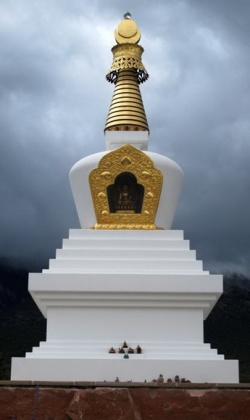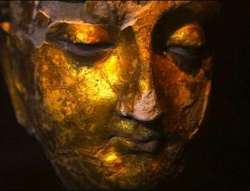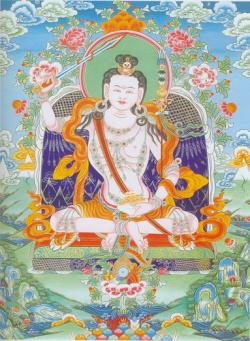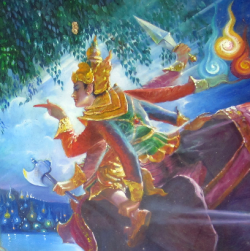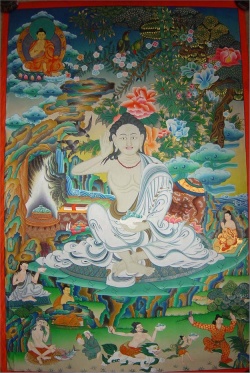Shakyamuni
- See also :
- See also :
Shakyamuni (ཤཱཀྱ་ཐུབ་པ་, shAkya thub pa; Ston pa shAkya thub pa)
Shakyamuni
釈尊・釈迦牟尼 (Skt; Jpn Shakuson or Shakamuni)
Also known as Gautama Buddha. The founder of Buddhism. "Shakyamuni" means "sage of the Shakyas," Shakya being the name of the tribe or clan to which his family belonged.
Opinions differ concerning the dates of his birth and death. According to Buddhist tradition in China and Japan, he was born on the eighth day of the fourth month of 1029 B.C.E. and died on the fifteenth day of the second month of 949 B.C.E., but recent studies have him living nearly five hundred years later.
The view prevalent among scholars is that Shakyamuni lived from about 560 to about 480 B.C.E., though some scholars hold that he lived from about 460 to about 380 B.C.E.
He was the son of Shuddhodana, the king of the Shakyas, a small tribe whose kingdom was located in the foothills of the Himalayas south of what is now central Nepal.
Shakyamuni's family name was Gautama (Best Cow), and his childhood or given name was Siddhartha (Goal Achieved), though some scholars say the latter is a title bestowed on him by later Buddhists in honor of the enlightenment he attained.
According to the Buddhist scriptures, Shakyamuni was born in Lumbini Gardens, in what is now Rummindei in southern Nepal.
His mother, Maya, died on the seventh day after his birth, and he was raised thereafter by her younger sister Mahaprajapati.
In his boyhood and adolescence, he is said to have excelled in both learning and the martial arts.
Though raised amid the luxuries of the royal palace, he seems to have very soon become aware of and been profoundly troubled by the problem of human suffering.
As a young man, he married the beautiful Yashodhara, who bore him a son, Rahula. He became increasingly possessed, however, by a longing to abandon the secular world and go out in search of a solution to the inherent sufferings of life.
Buddhist scriptures describe four encounters, which served to awaken in him an awareness of these four sufferings common to all people—birth, aging, sickness, and death—and a desire to seek their solution.
Eventually he renounced his princely status and embarked on the life of a religious mendicant.
Having left the palace of the Shakyas at Kapilavastu, Shakyamuni traveled south to Rajagriha, the capital of the kingdom of Magadha, where he studied first with Alara Kalama and then with Uddaka Ramaputta, both teachers of yogic meditation.
Though he quickly mastered their respective forms of meditation, he did not find the answers to his questions in these disciplines. Leaving Rajagriha, he proceeded to the bank of the Nairanjana River near the village of Uruvilva, where he began to engage in ascetic practices in the company of other ascetics.
For six years, he subjected himself to disciplines of appalling severity, far surpassing those of his companions, but he found it entirely impossible to reach emancipation through such self-mortification and eventually rejected these practices as well.
To restore his body, which had been weakened by long fasting, he accepted milk curds offered him by a girl named Sujata.
Then, near the city of Gaya, he seated himself under a pipal tree and entered meditation.
There he attained an awakening, or enlightenment, to the true nature of life and all things.
It was because of this enlightenment that he came to be called Buddha, or "Awakened One."
According to Buddhist tradition in China and Japan, Siddhartha renounced secular life at age nineteen and attained enlightenment at thirty.
(Modern scholars generally place these ages at twenty-nine and thirty-five, respectively.)
The pipal tree was later called the bodhi tree, bodhi meaning enlightenment, and the site itself came to be called Buddhagaya.
After his awakening, Shakyamuni is said to have remained for a while beneath the tree, rejoicing in his emancipation yet troubled by the knowledge of how difficult it would be to communicate what he had realized to others.
For a while, he vacillated as to whether he should attempt to teach others what he had achieved.
At length, however, he resolved that he would strive to do so, so that the way to liberation from the sufferings of birth and death would be open to all people.
First he made his way to Deer Park in Varanasi, where he preached and converted five ascetics who had formerly been his companions.
After that, Shakyamuni's efforts to propagate his teaching advanced rapidly.
In Varanasi he converted Yashas, the son of a rich man, and about sixty others. Then he headed back toward the site of his enlightenment, the village of Uruvilva near Gaya.
There he converted three brothers— Uruvilva Kashyapa, Nadi Kashyapa, and Gaya Kashyapa—who were leaders among Brahman ascetics, along with their one thousand followers.
The Buddha then set out for Rajagriha in Magadha, where he converted its king, Bimbisara, as well as Shariputra and Maudgalyayana, who would become two of the Buddha's leading disciples.
The latter two were at that time followers of Sanjaya, one of the six non-Buddhist teachers.
Together with Shariputra and Maudgalyayana, all of Sanjaya's followers—said to number 250—forsook him and entered the Buddhist Order. Maha-kashyapa also became another of the Buddha's disciples in Rajagriha shortly thereafter.
The Buddha made several trips to his childhood home, Kapilavastu, resulting in the conversion of many people, including his younger half brother Nanda, his son Rahula, his cousins Ananda, Aniruddha, and Devadatta, and a barber named Upali.
Shakyamuni's father, Shuddhodana, and his former wife, Yashodhara, are also said to have embraced the Buddhist teachings.
The Buddha permitted his foster mother, Mahaprajapati, to enter the Buddhist Order, and thus the order of Buddhist nuns was established.
At that time there was a powerful kingdom called Kosala that rivaled Magadha.
In Shravasti, the capital of Kosala, a wealthy and influential merchant named Sudatta became the Buddha's lay follower and patron.
He had met Shakyamuni while on business in Rajagriha and converted. Sudatta built Jetavana Monastery in Shravastias an offering to the Buddha, and Shakyamuni is said to have spent twenty-five rainy seasons at this monastery with his disciples. Prasenajit, the king of Kosala, also became a Buddhist.
In the fifty years (forty-five according to modern scholars) from the time of his awakening until he died, Shakyamuni continued to travel through much of India to disseminate his teachings.
Among the places where he concentrated his efforts were the cities of Rajagriha in Magadha; Shravastiin Kosala; Vaishali, capital of the Vriji confederacy; and Kaushambi, the capital of Vatsa.
The Buddha's disciples in the monastic order were also active in spreading his teachings. Mahakatyayana was a native of the kingdom of Avanti in the western part of central India and made several converts there, including the king.
Purna propagated Shakyamuni's teachings in Sunaparanta in western India north of present-day Bombay.
Thus even during Shakyamuni's lifetime, his teachings spread not only in central India but also to more remote areas, and people of all classes converted to Buddhism.
The new religious movement, however, was perceived by many as a threat to the old Brahmanic order, and in the course of his efforts Shakyamuni personally underwent numerous hardships, representative of which are the so-called nine great ordeals.
Persevering in the face of adversity, he continued to preach his message of emancipation, expounding the teachings in various ways according to the circumstances and capacity of his listeners.
The teachings he left are so numerous that they later came to be called the eighty thousand teachings.
Shakyamuni died at age eighty. The year before his death, he stayed at Gridhrakuta (Eagle Peak) near Rajagriha.
Then he set out on his last journey, proceeding northward across the Ganges River to Vaishali. He spent the rainy season in Beluva, a village near Vaishali.
During this retreat he became seriously ill, but recovered and continued to preach in many villages. Eventually he came to a place called Pavain Malla.
There he again became ill after eating a meal prepared as an offering by the village blacksmith, Chunda.
Despite his pain, he continued his journey until he reached Kushinagara, where in a grove of sal trees he calmly lay down and spoke his last words.
He admonished his disciples, saying: "You must not think that your teacher's words are no more, or that you are left without a teacher.
The teachings and precepts I have expounded to you shall be your teacher."
His final words are said to have been, "Decay is inherent in all composite things.
Work out your salvation with diligence."
His body was received by the Mallas of Kushinagara and cremated seven days later.
The ashes were divided into eight parts, and eight stupas were erected to enshrine them.
Two more stupas were built to house the vessel used in the cremation and the ashes of the fire.
In the same year, the First Buddhist Council was held in the Cave of the Seven Leaves near Rajagriha to compile Shakyamuni's teachings.

